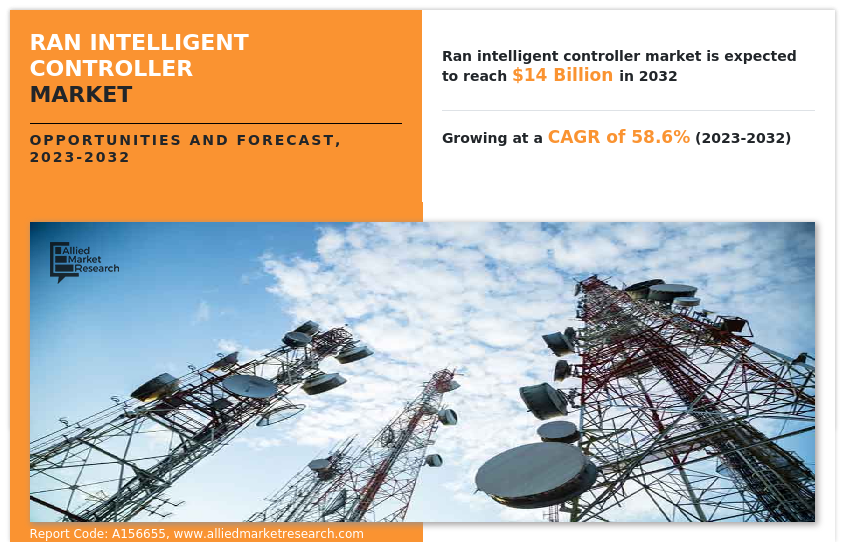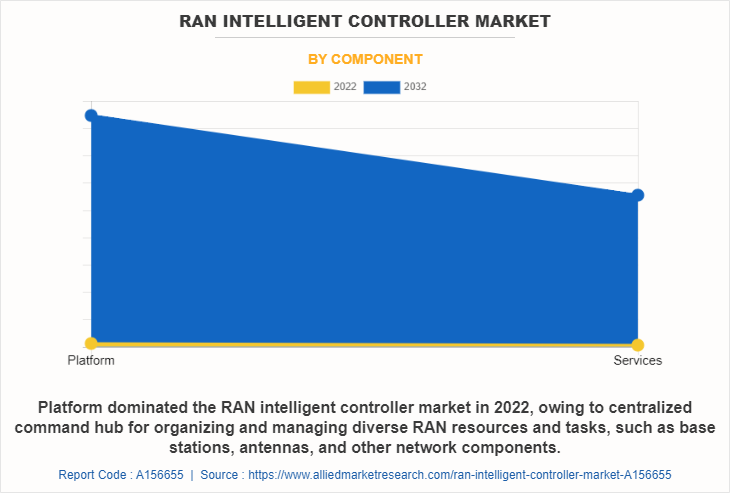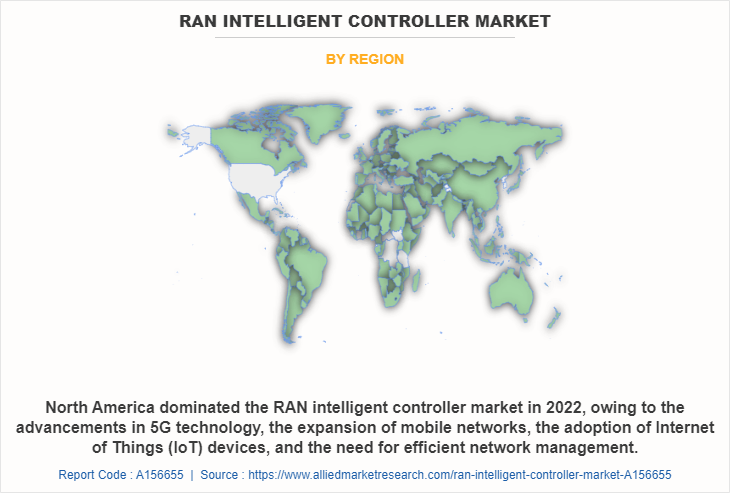RAN Intelligent Controller Market Statistics: 2032
The global RAN intelligent controller market was valued at $142.7 million in 2022, and is projected to reach $14 billion by 2032, growing at a CAGR of 58.6% from 2023 to 2032.
Factors such as rise in demand for network enhancement, collaboration across ecosystems, and open interfaces primarily drive the growth of the RAN intelligent controller market. However, the difficulties in implementation and integration hamper market growth to some extent. Moreover, a rise in demand for enhanced network management is expected to provide lucrative opportunities for market expansion during the forecast period.

The RAN (Radio Access Network) Intelligent Controller market refers to the market for intelligent controllers that are used to manage and optimize the operations of the Radio Access Network in telecommunications infrastructure. By automating network configuration and management processes, it is intended to make mobile network operation & maintenance simpler and boost network performance. The increase in implementation of 5G networks and cloud-based solutions are the main factors that drive the market for RAN Intelligent Controllers. One of the main forces behind the development of 5G networks is RAN Intelligent Controller. Operators need innovative network automation and management solutions to optimize network performance and save operating costs due to the surge in complexity of 5G networks. Moreover, the demand for RAN Intelligent Controller is being driven by the increase in complexity of mobile networks. Operators need innovative network management solutions to guarantee optimal network performance and user experience as connected devices and data traffic keep growing.
The market for RAN (Radio Access Network) Intelligent Controllers is rapidly growing and is anticipated to do so for the coming few years. The surge in the telecommunications sector's need for innovative network management and optimization solutions is what propels market growth. RAN Intelligent Controllers (RICs), between the RAN hardware and the core network, are software-defined network components that offer improved control and coordination capabilities.
The RAN intelligent controller market is segmented on the basis of component, function, technology, application, and region. On the basis of component, it is bifurcated into platform and services. On the basis of function, it is segregated intoNon-Real-Time-RAN Intelligent Controller (Non-RT RIC) and Near-Real-Time-RAN Intelligent Controller (Near-RT RIC). On the basis of technology, it is fragmented into 4G and 5G. On the basis of application, it is categorized into rApp and xApp. On the basis of region, it is analyzed across North America, Europe, Asia-Pacific, and LAMEA.
The global RAN intelligent controller industry is dominated by key players such as Telefonaktiebolaget Lm Ericsson, Nokia, Huawei Technologies Co., Ltd., Intel Corporation, Samsung, ZTE Corporation., Cisco Systems, Inc., NEC Corporation, Juniper Networks, Inc., Vmware, Inc. These players have adopted various strategies to increase their market penetration and strengthen their position in the RAN intelligent controller industry.

On the basis of component, platform segment dominated the RAN intelligent controller market share in 2022 and is expected to maintain its dominance in the upcoming years, owing to centralized command hub for organizing and managing diverse RAN resources and tasks, such as base stations, antennas, and other network components. The RIC platform makes intelligent judgments based on real-time data analysis and machine learning algorithms to improve user experience and network performance. However, the service segment is expected to witness the highest growth, owing to wide range of features and capabilities, such as real-time analytics, resource optimization, and centralized network management. The RIC service uses cutting-edge technology like artificial intelligence and machine learning to analyze network data and make wise decisions that improve user experience and network performance.

Region wise, North America dominated the RAN intelligent controller market size in 2022 and is expected to maintain its dominance in the upcoming year, owing to the advancements in 5G technology, the expansion of mobile networks, the adoption of Internet of Things (IoT) devices, and the need for efficient network management. However, Asia-Pacific is expected to witness the highest growth, owing to developing countries such as China and India the adaption of smart technologies such as AI and ML escalates the demand for RAN intelligent controller. In addition, with the proliferation of smartphones, IoT devices, and digital services, there has been an exponential increase in data traffic across mobile networks in the Asia-Pacific region.
Top Impacting Factors
Rising Demand for Network Enhancement
As RIC enables network operators to improve the performance and efficiency of the radio access network (RAN), network optimization is an important factor behind the RAN Intelligent Controller (RIC). Network optimization is essential for achieving optimal network performance and user experience due to the surge in complexity of 5G networks and the requirement for effective resource allocation. To optimize multiple RAN components, the RIC serves as a centralized intelligence hub that makes use of innovative algorithms, artificial intelligence (AI), and real-time network insights. To get a thorough picture of the network's performance and behavior, it gathers and analyzes data from various network components, including base stations, antennas, and user devices. The RIC makes data-driven judgments and automates network optimizations through the processing of this data.
The dynamic allocation of radio resources is one facet of network optimization made possible by the RIC. Moreover, the real-time monitoring and analysis capabilities of the RIC enable operators to distribute radio resources more effectively, such as frequency bands and power levels. The RICs optimizes radio resource utilization, lessen congestion, and make sure that resources are deployed where they are most required by dynamically modifying resource allocation based on network demand. With the help of this optimization method, network capacity, latency, and user experience are all improved. Interference impair the RAN's performance in a congested network environment, resulting in decreased throughput and diminished signal quality.
Rising Demand for Network Enhancement
The RAN Intelligent Controller (RIC) is driven by open interfaces and ecosystem collaboration, which support interoperability, vendor neutrality, and innovation in the telecommunications sector. Network operators incorporate solutions from several suppliers, minimize vendor lock-in, and promote a competitive market due to the RIC's focus on open interfaces and collaboration. Within the RAN infrastructure, open interfaces are essential for facilitating interoperability between various parts and providers. Base stations, antennas, and network management systems are seamlessly integrated into the network due to the RIC's open APIs and standardized interfaces. Instead of being limited to the options of a single vendor, this interoperability ensures that operators have the freedom to select the best-in-class solutions from a variety of providers.
Open interfaces make it simpler to integrate with third-party software and services, fostering a more vibrant and creative environment. Moreover, the RIC fosters cooperation and innovation among developers by supporting vendor neutrality. The open and standardized interfaces of the RIC offer a platform for suppliers and third-party developers to build xAppand rApp, applications that improve the capabilities and functionalities of the RAN. This collaborative setting encourages competitiveness and pushes programmers to build novel ideas, test out novel functionality, and tackle new problems in the RAN. The RIC serves as a catalyst for industry innovation by giving innovators a place to work together and introduce fresh products and services to the market.
Key Benefits for Stakeholders
- This report provides a quantitative analysis of the market segments, current trends, estimations, and dynamics of the ran intelligent controller market analysis from 2022 to 2032 to identify the prevailing ran intelligent controller market opportunities.
- The market research is offered along with information related to key drivers, restraints, and opportunities.
- Porter's five forces analysis highlights the potency of buyers and suppliers to enable stakeholders make profit-oriented business decisions and strengthen their supplier-buyer network.
- In-depth analysis of the ran intelligent controller market forecast assists to determine the prevailing market opportunities.
- Major countries in each region are mapped according to their revenue contribution to the global RAN intelligent controller market growth.
- Market player positioning facilitates benchmarking and provides a clear understanding of the present position of the market players.
- The report includes the analysis of the regional as well as global ran intelligent controller market trends, key players, market segments, application areas, and market growth strategies.
RAN Intelligent Controller Market Report Highlights
| Aspects | Details |
| Market Size By 2032 | USD 14 billion |
| Growth Rate | CAGR of 58.6% |
| Forecast period | 2022 - 2032 |
| Report Pages | 348 |
| By Function |
|
| By Component |
|
| By Application |
|
| By Technology |
|
| By Region |
|
| Key Market Players | ZTE Corporation., VMware, Inc., Samsung, Nokia, Juniper Networks, Inc., Telefonaktiebolaget LM Ericsson, NEC CORPORATION, Huawei Technologies Co., Ltd., Cisco Systems, Inc., Intel Corporation |
Analyst Review
5G network features such as network slicing and low-latency applications, the Radio Access Network (RAN) is crucial. In addition, the COVID-19 pandemic increased mobile internet traffic, which increased the requirement for its effective management? and accelerated the uptake of RAN intelligent controller solutions. Governments have assumed leadership roles and made investments in R&D to advance 5G technologies. Moreover, to improve their services and maintain their competitiveness in the industry, the major market players have invested in R&D. The market is fueled by the telecommunications sector's shift toward network virtualization, automation, and AI. In order for operators to take advantage of new technologies and increase the flexibility and efficiency of their networks, RICs are essential. In addition, the market for RAN Intelligent Controllers is anticipated to experience rapid expansion as operators continue to invest in 5G network deployments and attempt to improve network performance. The market has chances for industry participants to innovate and work together, and it is anticipated that new and innovative RIC solutions need to be introduced. Furthermore, the telecommunications industry's need for sophisticated network management and optimization solutions augments the growth of the market for RAN Intelligent Controllers. RICs are essential in helping operators to improve network performance and efficiency with the rollout of 5G networks and the surge in usage of virtualization and automation. To address the changing needs of the business, the market offers players the chance to create innovative solutions and work with operators.?
For instance, in February 2023, Reston, VA USA, P.I. Works, a leading provider of AI-driven mobile network automated management and optimization solutions, announced the launch of its new Radio Access Network (RAN) Intelligent Controller (RIC) to further enhance its EXA product offering and increase its automation use-cases through a wide range of its existing and 3rd party rApp. Flexibility, open interfaces as well as increased efficiency by virtualization of Open RAN network standards developed by the O-RAN Alliance, generate great interest of mobile operators toward Open RAN networks. However, deployment of Open RAN in an existing network, consisting of purpose-built network elements, is a complex and challenging task. Therefore, a centralized automation solution with standardized interfaces is essential for the operators to manage hybrid networks.
Factors such as rise in demand for network enhancement and collaboration across ecosystems are the upcoming trends of RAN Intelligent Controller Market in the world
Rise in demand for enhanced network management is the leading application of RAN Intelligent Controller Market
North America is the largest regional market for RAN Intelligent Controller
The global RAN intelligent controller market was valued at $142.68 million in 2022 and is projected to reach $14013.96 million by 2032, registering a CAGR of 58.6% from 2023 to 2032.
The global RAN intelligent controller industry is dominated by key players such as Telefonaktiebolaget Lm Ericsson, Nokia, Huawei Technologies Co., Ltd., Intel Corporation, Samsung, ZTE Corporation., Cisco Systems, Inc., NEC Corporation, Juniper Networks, Inc., Vmware, Inc. These players have adopted various strategies to increase their market penetration and strengthen their position in the RAN intelligent controller industry.
Loading Table Of Content...
Loading Research Methodology...


